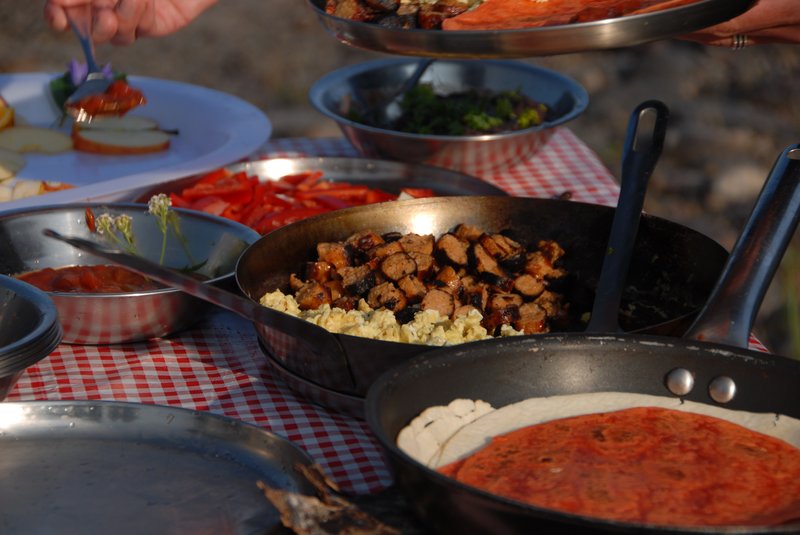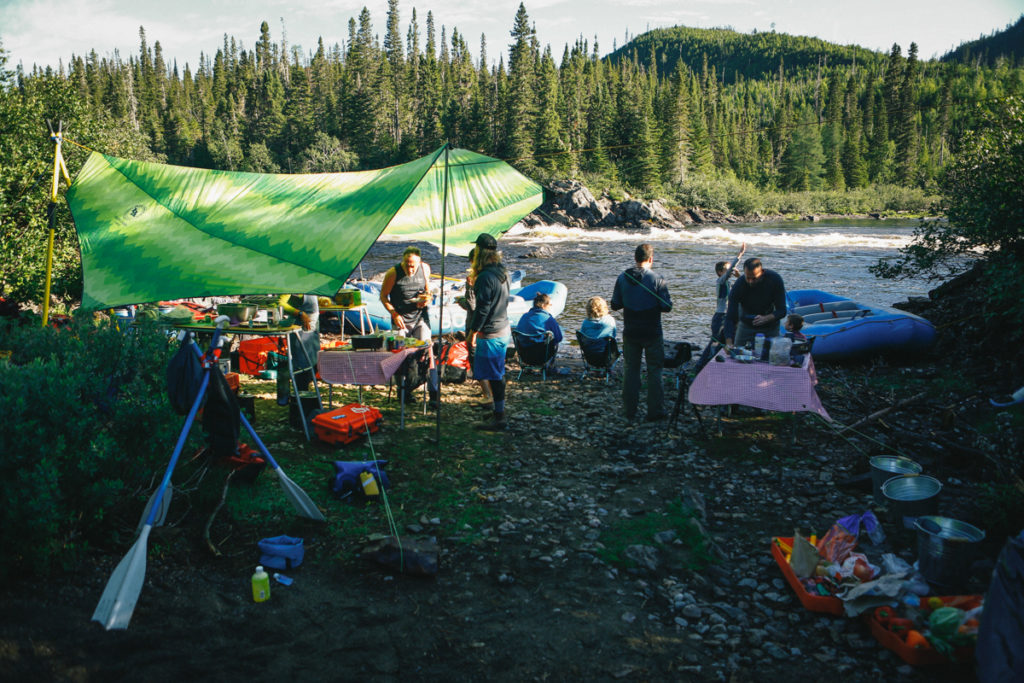Expedition Food Systems
Planning an expedition menu that is tasty, nutritious, affordable, and sustainable is an art. Here are some basic systems to get you started.

Fresh food livens up your meals
Carrying fresh food can add a lot of excitement to trip meals. How much food to pack fresh depends on the trip you have planned. Weight and space are important considerations both for portaging and boat performance on the water.
While it is a good idea to plan out what fresh food you need for each meal, you’ll also need to be ready to adjust based on what needs to be eaten right away. A good method is to keep all the fresh food in one place, instead of with individual meals, and to look through it every night to determine what needs to be used. Packing some optional dried ingredients for later meals can help with this flexibility. If you end up having enough fresh food, then the dried food can be saved for later, or kept for a future trip.
As a general rule, harder or drier fresh foods last longer. This goes for meat, cheese, fruits and vegetables, and bread. It can help to categorize fresh food by how long you can expect it to last. Here are some examples:
First 24-48 Hours
- Most Dairy
- Fresh or cooked meat
- Soft Fruits (berries, plums, etc.)
- Delicate greens (lettuce, asparagus)
First Week
- Most Vegetables (broccoli, cauliflower, peppers, tomatoes, zucchini, radishes, green beans)
- Dense, unsliced bread
- Pita Bread
- Eggs
Longer Trips
- Cheese
- Butter
- Hard “summer sausages”
- Root vegetables
- Apples
- Flour or Corn tortillas
Tips to store fresh food longer
There are several things you can do to maximize the storage time of your fresh food, especially fruits and vegetables:
- Make sure it doesn’t bruise – pack softer things on top, but remember that a barrel spends most of the day on its side!
- Keep it out of the sun – spraydecks help a lot, as well as planning kitchens to keep fresh food in the shade.
- Manage moisture – pieces of corrugated cardboard packed with vegetables can absorb excess moisture. Keep fresh food barrels open when possible to vent moisture.

Save weight with DIY dehydrated food
In addition to leaving behind the water weight, dehydrated food lasts almost indefinitely, so it is a great choice for longer trips, or ones with a lot of portages or technical whitewater. There is a wide array of dehydrated food available, but dehydrating your own opens up a whole world of possibilities for creative, affordable meals. If you are able to plan far enough in advance, you can even take advantage of seasonal produce available in the fall to make your dehydrated food for the next season.
A dehydrator can be as simple as an oven at minimum temperature (usually 170 F) with the door held ajar with a wooden spoon. Some foods can even be dehydrated outside on a hot day. Electric dehydrators give more temperature control, and are more reliable. All kinds of food can be dehydrated, but as a general rule, avoid anything with a high fat or oil content, which could go rancid. These are some of my favourites:
- Tomato paste turns into a fruit leather consistency. Tear or cut into small pieces, and rehydrate in boiling water to make a tomato sauce. Tomato halves or slices dry like sun dried tomatoes, and are great for giving more texture to tomato sauce, as a garnish, or as a pizza topping.
- Hummus dries to a powder. If you are making your own, keep out the oil and add it when rehydrating, along with warm water.
- Yogurt dries to a leathery consistency and makes a great snack as is – think yogurt covered peanuts or raisins.
- Applesauce makes a great base for fruit leather – try adding in other chunks of fruit or some jam or jelly.
- Cooked beans dehydrate well, and can save the weight of carrying cans, or the time spent soaking and cooking dried beans. Beans can be pre-spiced for a quick meal, or you could even try dehydrating a whole chili.
- Apple rings dry crispy, like chips, and are way tastier than the chewy ones you can buy in bulk.
- Strawberries aren’t great dry, but rehydrate to make a delicious topping for pancakes or a dessert.
- All kinds of vegetables including onions, peppers, kale, carrots, and potatoes – Vegetables that take longer to cook (especially potatoes) should be steamed or blanched first until soft. Otherwise, they will be slow to cook when rehydrated.
- Jerky can be made with beef, chicken, venison, or other lean cuts of meat (avoid high fat content, which can cause jerky to go rancid). Partially thawed meat is easiest to cut into thin strips. Try out different marinades for jerky with a lot of flavour.
Manage food waste like an expert
One of the more frustrating things to deal with on a canoe trip is food waste. It can be hard to gauge food amounts as appetites and level of activity change, and no one wants to be the person who didn’t make enough dinner. Here are some tips for decreasing waste:
- When choosing amounts, consider how exciting it will be to have leftovers. No one will complain if there is extra pizza or pancakes to save for a snack, but cold oatmeal is never very appetizing.
- Adjust amounts as you get to know how much the group eats, and as appetites change. Setting aside some of the dry ingredients for a meal not only cuts down waste, but gives you back-up/emergency food for later in the trip.
- Consider making a smaller amount of hot cereal for breakfast, and having other things available for anyone who is still hungry (dried fruit and nuts, granola, muffins, fruit)
- Tupperware containers (the sturdy ones with good lids!) make great storage for leftover dinners, which can be eaten cold or hot with lunch, or reheated with the next dinner.
- Flour tortillas or pitas can turn a leftover stir fry or chili into a great lunch wrap
- Have a “pantry” of extra staples (grains, flour, soup packets, etc.). This gives you the security of extra food without having to over-pack each meal.
Sustainable trip food
Many people doing canoe trips understand and follow leave-no-trace practices. Taking care of the places we travel in is important, but we should also acknowledge the impacts or “traces” that a trip has on other places. This extension of the leave no trace ethic means considering the impacts of the gas it takes to get to a river, the gear that is purchased for a trip, and of course, the food we pack.
When it comes to food, the foundation of this “bigger picture leave no trace” ethic is careful planning and preparation using systems like the ones above. Beyond these basics, however, there are many other things that can make your food choices more sustainable.
In the past few years, more and more people seem to be making an effort in their daily lives to eat in-season produce, buy direct from local farmers, and source more ethical meat, dairy and eggs. However, these choices sometimes fall by the wayside when it comes to expedition menu planning. How do you make your trip food more sustainable? What stands in the way of changes you’d like to make? Share your thoughts with us.

